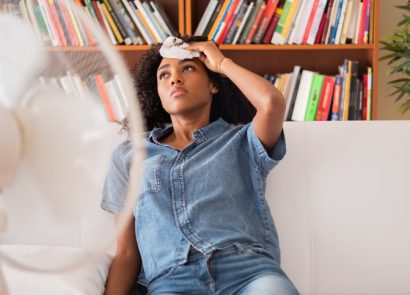At least one in three women will experience some form of hair loss in their lifetime, so if you can see more hair going down the drain than usual during your morning shower, know that you’re probably not going to go bald. The two most common hair loss conditions are androgenic alopecia, which consists of hair thinning, reduced hair volume, female pattern hair loss, and telogen effluvium, an excessive daily loss of hair.
Androgenic alopecia
Commonly known as female pattern hair loss, or hair thinning, androgenic alopecia is a very slow, progressive reduction in hair volume that happens because of your genes. If you have androgenic alopecia, then your hair follicles will gradually shrink and start to produce slightly finer and shorter hairs with each passing hair growth cycle. So if you experience hair loss because of this condition, it’s not necessarily that you have fewer hairs than you used to, but that the replacement hairs are taking up less space on your scalp. While genes are at the root of this type of hair loss, certain factors can make it worse, such as stress, the menopause, and polycystic ovarian syndrome, (PCOS). It’s important to realise that hair reduces in volume naturally as we get older. Just like our skin and muscles, the hair follicle ages and changes.
Telogen effluvium
Telogen effluvium is a reactive type of hair loss, and it occurs when more hair grows rather than sheds. Unlike androgenic alopecia, it’s easier to spot as you’ll notice more hairs coming out when you shampoo and style. Hair is often the first part of us to suffer when something is amiss, so this hair loss can be triggered by poor diet and nutritional deficiencies, most commonly iron, vitamin B12, and vitamin D deficiency, hypo or hyperthyroid, as well as illness and stress. Due to the nature of the hair growth cycle, it takes six to twelve weeks for hair to fall out, so if you’re losing more hair than normal, take a look at the last few months for a possible cause. Up to 50 percent of women also experience post-partum hair loss, which is an excessive daily loss of hair which occurs roughly three months after giving birth or stopping to breastfeed.
4 tips to help prevent hair loss
Manage your stress levels:
Take a walk and make sure you get your daily exercise. Try yoga, Pilates, meditation, swimming, light exercise, and mindfulness.
Never skip breakfast:
Breakfast is the most important meal of the day for your hair as it’s when energy levels to your follicles are at their lowest. A hair healthy breakfast will include a protein and complex carbohydrate. Great examples are poached eggs on toast, quinoa porridge with berries and toasted almonds, and a smoked salmon bagel.
Watch out for nutritional deficiencies:
If you know you’re deficient in a certain vitamin or mineral, make the appropriate changes to your diet and take a relevant nutritional supplement. As hair is non-essential tissue, it’s the last part of us to receive nutrients and the first to be withheld from. This means if your diet is lacking, the nutrients you do get will be used to keep your essential systems functioning, with your hair receiving little if any.
Minimize breakage:
Breakage can thin the appearance of your mid-lengths and ends, so use a weekly pre-shampoo conditioning treatment to restore elasticity and strength.





















